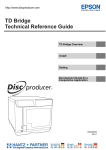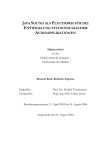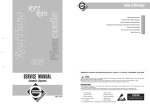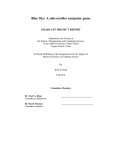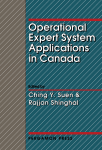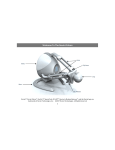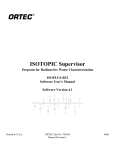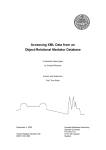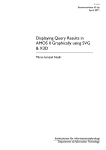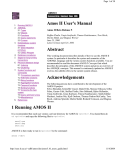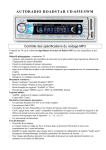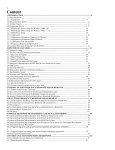Download Searching contents of wrapped MP3 files from an Object
Transcript
Uppsala Student Thesis in
Computer Science 310
2007-05-27
Searching contents of wrapped
MP3 files from an Object-Relational
Mediator System
Thomas Schreiter
Information Technology
Computing Science Department
Uppsala University
Box 337
S-751 05 Uppsala
Sweden
Supervisor: Erik Zeitler
Examiner: Tore Risch
Abstract
Amos II is a mediator system developed at the database department
of Uppsala University. It provides the Query Language AmosQL, which
is an object oriented expansion of SQL. ISO-MPEG Audio Layer-3 files
(also known as MP3) contain music. One wants to treat an MP3 file as a
source of data and analyze its content. To query an MP3 file via Amos II,
one has to wrap the MP3 files to get access to them. The basic approach
to this integration is to send the data from the MP3 file to Amos II in a
streamed fashion. This paper describes the work to build such a wrapper.
1
Contents
1 Introduction and Motivation
3
2 Analysis of the given systems and Specification of the
Wrapper and the Filter
2.1 Specification of the new system . . . . . . . . . . . . . . . .
2.2 Analysis of Amos II . . . . . . . . . . . . . . . . . . . . . .
2.3 The technology of MP3 . . . . . . . . . . . . . . . . . . . .
4
4
4
5
3 Design of the Wrapper and the Filter
3.1 General Issues . . . . . . . . . . . . . . . . . . . . . . . . . .
3.2 Design of the Wrapper . . . . . . . . . . . . . . . . . . . . .
3.3 Design of the Filter Functions . . . . . . . . . . . . . . . . .
7
7
8
9
4 Implementation and Usage of the Wrapper and the
4.1 General Issues . . . . . . . . . . . . . . . . . . . . . .
4.2 Implementation of the Wrapper . . . . . . . . . . . .
4.3 Implementation of the Filter Functions . . . . . . . .
4.4 Installation . . . . . . . . . . . . . . . . . . . . . . .
4.5 Demo and Usage of the System . . . . . . . . . . . .
Filter
. . . .
. . . .
. . . .
. . . .
. . . .
12
12
13
14
17
18
5 Summary and Outlook
19
5.1 Known issues . . . . . . . . . . . . . . . . . . . . . . . . . . 19
5.2 Beyond... . . . . . . . . . . . . . . . . . . . . . . . . . . . . 21
A Notes on Feature Extraction of Music
22
A.1 Existing Programs and Papers . . . . . . . . . . . . . . . . 22
A.2 Pandora: A Music Discoverer . . . . . . . . . . . . . . . . . 23
2
1
Introduction and Motivation
There are some technologies how to store music in a digital way. This
paper deals with the most popular version of music files nowadays: the
ISO-MPEG Audio Layer-3 files, better known as the abbreviation MP3.
These files are divided into two parts. The first part contains metadata about the song. Information about the author, the length of the
song, the sampling rate, the version number of the used encoding technique and much more is stored there. The second part of the MP3 file
contains the actual music. To analyze the actual content of a music file
the binary coded music has to be cracked out of the files and be decoded
into a stream.
Figure 1: Content of this paper
The Amos II mediator system enables the integration of different types
of data from different sources of data. Usually, the data sources are a priori
not compatible with the Amos II system. To get access to the data source
we have to implement an adapter between the data source and Amos.
The adapter will translate the access functions of the data source into
functions of the Amos system. Such an adapter is also called a wrapper.
There is already a wrapper existing [15]. This wrappers enables the
querying of the meta data of an MP3 files. These data are stored in
the file separately from the actual encoded music. These are information
about the author of the song, the genre of the song, the used encoding
technique and more. This paper covers the development of a wrapper
between Amos II and the music or content of MP3 files (Fig. 1). The
content has to be accessed and wrapped with functions to provide the
information to Amos II and its querying language AmosQL. It will be a
demonstration of AmosQL’s flexibility.
So, we will connect the two objects “Amos II” and “MP3 file” by their
data at a low level. This technique of connecting two or more systems to
one working unity by their data structures is called Information-oriented
Application Integration [12].
This paper’s structure is as follows: Chapter 2 specifies the task of
this project, including the wrapper and the filter functions. Furthermore
the the Amos II system and the structure of music files will be analyzed.
The design of the wrapper and the filters are described in Chapter 3.
These techniques will be implemented, as Chapter 4 shows. One will also
find the description of usage, the installation and a demonstration of this
integrated system. An summary and outlook is given in chapter 5.
3
2 Analysis of the given systems and Specification of the Wrapper and the Filter
2.1
Specification of the new system
The specification of the system is brief and informal and divided into two
parts:
1. “Enable a mechanism to read out the data of an MP3 file. The focus
is on the music itself, not on the meta-data.”
This part will provide the decoded music to the Amos environment.
So we have to wrap the MP3 files. This part of the project will be
referred to as the wrapper part.
2. “Enable a mechanism to perform an analysis on the MP3 music
data to extract features. In this part use the language features of
AmosQL.”
This part avails the results of the first part. We will develop interesting analyzing functions and implement them with the language
features of AmosQL. This part of the new system will be referred to
as the filter part.
This specification is written generally. Thus, it provides flexibility to
adapt if there are serious problems.
In the next chapter we will analyze the system Amos and we will take
a closer look at MP3 technology. After that we can outline the parts of
the new system more clearly. Then we design the new system in chapter 3.
2.2
Analysis of Amos II
This chapter introduces the most important concepts and constructions
of the Amos II system. At the homepage of the database laboratory of the
Uppsala university are detailed tutorials located which are worth reading
[11, 8]. In [7] Amos is described as:
Amos II (Active Mediator Object System) is a distributed mediator system that uses a functional data model and has a relationally complete functional query language, AmosQL. [. . . ].
Functional multi-database queries and views can be defined
where external data sources of different kinds are translated
through Amos II and reconciled through its functional mediation primitives. [. . . ] The Amos II data manager and query
processor are extensible so that new application oriented data
types and operators can be added to AmosQL, implemented in
some external programming language (Java, C, or Lisp). The
extensibility allows wrapping data representations specialized
for different application areas in mediator peers. The functional data model provides very powerful query and data integration primitives which require advanced query optimization.
The core application of AmosQL is the usage of query statements.
AmosQL is an extension to SQL, so it enables the SQL typical select
statements as well as create and the insert statements.
4
Amos II’s goal is to connect different data sources to one working
database. To access and use the stored data, Amos enables a typing
system which allows to define own types. Basic types like integer and real
numbers are implemented as well as vectors and bags. New types can be
developed be inheriting the features of an existing type or be defining a
completely new one.
Amos supports functions. Three different concepts will be introduced:
• Stored functions do not compute the return value in a mathematical
sense, but it looks up the result in its own database. The result is
stored in the database.
• Derived functions are composite functions. They use the SQL part
with its select operations or call other functions to calculate their
result.
• Foreign functions are implemented in an foreign language. AmosQL
is specialized to database queries and is not adequate to compute
difficult numerical algorithms. Such algorithms can be implemented
in a foreign programming language. A foreign function is basically
a call to the interface of the foreign programming language. There
exist interfaces to Java, C and Lisp.
2.3
The technology of MP3
In this part we will analyze the structure of an MP3 file.
MP3 is standardized by the MPEG Committee. This group is engaged
in creating standards for the compression of audio and video signals. It
defines the syntax of audio and video format and the operations of decoders.
The meta data of an MP3 file
As mentioned before, an MP3 file is divided into two parts – meta data
of the song and the actual music. The meta data about song are stored
in a table at the header of the file – or sometime in the trailer, depending
on the encoding technology. It contains information about
• the used encoding technique and version
• the number of channels (mono/stereo)
• the sampling frequency and the nominal bit rate
• the length in bytes and in frames
• the frame rate, the frame size of the first frame and other very specific
information about the encoding
• the copyright of the song
• the author, the album and the genre of the song
This first part of an MP3 file is, as mentioned before, already wrapped
for the Amos II system [15].
The actual music in an MP3 file
The second and major part of an MP3 file contains the actual, encrypted
music. We will take a short look at the techniques of encoding music to
an MP3 file [10].
5
Music, or sound in general, is the vibration of air. These vibrations
are perceived by the human ear and transformed in the human brain
to a sensory perception. The human being cannot recognize all types of
sounds. We only can hear sounds of frequencies between 16 Hz and 20 kHz.
Whereby we are more sensitive in perception in some frequencies than in
others. For example, we are very sensitive at hearing quiet sounds in the
range between 2 kHz and 5 kHz.
Additionally, in an almost silent environment we can hear the sound
of our own breathing. But, in contrast, in a loud room we do not hear our
breathings, because our senses are distracted by the noise. These two “features” of the human sense of hearing are called non-linear audio threshold
and masking effect, respectively. These are in great use of reducing the
amount of data while encoding music. This is called perceptional coding.
During the compression, some minor and unimportant details of the
music are omitted. The song details the human being is not capable of
hearing are suppressed by the perceptional coding. So, some information
get lost, but the result is not changed in a great manner. Comparing the
original song with an encoded and re-decoded song shows no difference to
the human ear. The songs seem to sound the same.
There are some more techniques used in the encryption algorithm.
Since the two streams of the left and the right stereo do not differ that
much, they are coded bundled by the Joint Stereo coding. At the end of
the compression the calculated symbols are finally encoded with a Huffman code. This is a very fast algorithm that saves up to 20 % of space.
The encoding takes a lot of time. But the initial bitrate of 768 kBit/sec
are reduced to 128 kBit/sec or even less.
An MP3 file is structured as follows: It consists of a header containing
the meta-data and a body containing the actual music.
The body consists of frames which have the following features:
• Each frame has a 32 bit header containing information about the
synchronization and encoding of the frame
• Each frame represents audio data of a duration of 26 ms, that are 38
frames per second
• Each frame contains exactly 1152 samples
• The sampling frequency is Fs = 44 kHz
The way of encoding and decoding MP3 files is an asynchronous one.
The encoding takes a lot more time than the decoding. But the latter is
much faster. It is possible in real time, obviously. A lot of operations have
to be performed. Figure 2 depicts the necessary operations. The MPEG
committee standardized these operations, so there are lots of decoders
built and available.
The input to the decoder is an MP3 file. The decoder skips the meta
data of the MP3 file and scans the frames of the body. The information of
each frame header are used to synchronize the decoding, enable the correct
Huffman decoding scheme, enable the correct bitrate and the other important decoding parameters. The decoding procedure contains the decoding
of the Huffman symbols, a cosine transform, the stereo decoding, Alias
Reduction, and some other functions. The final stage transfers the signal
into the (discrete) time domain representing a (discrete) sound wave. So,
at no point during the decoding do the data represent the sound in the
frequency domain.
6
Figure 2: MP3 decoder structure [9]
The conclusion: The encoded data in the MP3 file are a priori not
useful for any analysis of the music. While decoding the file, data are
transformed to different stages, but no one of them represents the information in a useful way. The result of the decoding is a bit stream
representing the time domain of the sound. Every 16 bit are one PCM
sample (PCM stands for Pulse Code Modulation). A positive value is a
positive value of the amplitude, a negative value a negative amplitude at a
certain point in time. So, the whole output stream is a digital waveform,
quantized in time and amplitude.
3
Design of the Wrapper and the Filter
3.1
General Issues
We have three major parts to regard.
1. Accessing the MP3 files, decoding them and delivering the result to
Amos II.
2. Analyzing the result by filter functions in Amos II.
3. Storing the extracted features in the Amos II database.
The first big part of decoding an MP3 file cannot be done by the language
capabilities of AmosQL. So this part will be implemented by a foreign
function. The design of the decoding part will be discussed in section 3.2.
The filter functions will deal only with feature extractions of low level.
AmosQL provides simple functions like addition, multiplication, minimum, vector operations and so forth. Additionally, queries known from
the SQL select-statement serve as a good basis to design the filter functions with the concept of derived functions. Chapter section 3.3 explains
the design of the filter.
These attained result will be stored in the Amos system. AmosQL
and its concept of stored functions are the perfect instrument so create a
7
Figure 3: Design of the Wrapper
database of the analyzed songs.
3.2
Design of the Wrapper
Amos does not provide built-in functionalities to access and decode MP3
files. So, we will use a foreign program to achieve the desired function of
retrieving decoded PCM samples of MP3 files. For that reason we have
to develop an own program to access and handle the actual MP3 decoder.
It acts as a handle of the decoder.
The basic way of accessing the MP3 files is as follows (Figure 3):
1. in AmosQL: get the file name of the MP3 file and the decoding
parameters
2. in AmosQL: call the foreign decoder handler
3. in decoder handler: open the MP3 file and call the actual decoder
4. the decoder returns the result in a stream to the decoder handler
5. in decoder handler: format this result to an object that Amos can
understand
6. in decoder handler: emit this object to AmosQL, end after MP3 file
is decoded
7. in AmosQL: receive the decoded PCM samples
The decoder
The main and central point of this wrapper design is to find an MP3
decoder. In the Internet one can find hundreds of decoders. But only
a fistful of them are satisfactory enough to be worth to be used. The
following list describes some of them, including the reasons why I have
chosen or rejected them, respectively:
• The madlib library [6] provides a good and general basis to decode
MP3 files. It has been build at the year 2000 and being improved
until 2004. A lot of other programs use its functionalities. Unfortunately, the documentation is very small and does not give the necessary information for this thesis. But a least a little demonstration
program is attached to show an instance of usage.
8
So I had to read the source code by my own. The programming language used is C, which promises a fast execution time. The code is
very generally written, the use of function pointers provide a useful
flexibility. But on the other hand, some very C special features and
qualities might provide a fast decoding algorithm, but it is very hard
to read for a new developer. To show three examples: assignment in
an if-condition, more than one return command in a function, function calls in combination with boolean operators in an if-condition.
And to top it off, the goto-commands make it virtually impossible
to understand the code within few hours.
Conclusion: It might be a great program, but the lack of a comprehensive documentation is a killing factor. We have only a small
project and need only the basic functionality of decoding an MP3
file. So it is not worth to get that deep into the library.
• Audiere [1] is a library to decode music files. A documentation is
available. But, again, it is a small documentation. Anyway, at the
moment Audiere is not supporting MP3 file due to the license of the
decoder algorithms. Maybe they will include it again in the near
future. So Audiere is not a choice now.
• The decoder called mpg123 [3] has very good test results. Unfortunately, the latest version has a huge security bug and it is not further
developed.
• Java provides an MP3 decoder within its distribution. The usage of
audio streams let the code look short and clear. We will use the code
of the already existing MP3 meta data wrapper [15], that contains
also a little routine to playback MP3 files by using audio streams.
So that seams to be the best way to decode MP3 files into PCM
Streams. The runtime might be slower than the decoders written in
C, but the short development time is the evident reason to use Java.
So, our choice will be to use Java as decoder. For that reason the handler
of the decoder will be implemented in Java, too. The both parts “decoder”
and “decoder handler” will be implemented in Java in one source code file.
The decoder handler
From Amos to the Decoder: After a foreign call by Amos, the decoding
information are extracted and the decoder will be constructed. The decoder is basically an object of the class AudioInputStream, which is part
of the distribution of Java 1.5.
From Decoder to Amos: The decoder returns a stream of PCM samples
in a byte-oriented way. The samples values have to be calculated. They
are then bundled to vectors of PCM samples. After that they are send to
Amos.
3.3
Design of the Filter Functions
As discussed previously, the decoder emits vectors of PCM samples of
an MP3 file to Amos II. We have to design analysis functions to extract
features of the MP3 file:
9
• The maximum amplitude of a song is highest value of the music
signal in the time domain. It is simply an iteration over all PCM
samples and returning the highest value. The function name will be
AnaSongMaxAmplitude().
• The energy spectrum of a song is an analysis of the frequency spectrum of the song. It is a value describing the dispersion of the energy
value of each frequency in the song. This is a nontrivial computation
and we will discuss it in more detail soon. The name of the function
will be AnaSongEnergySpecSmall().
• The frequency with the highest energy is that frequency in the
song, that is stronger than all others. This is an analysis of the
energy spectrum and returns a frequency/energy pair describing the
strongest frequency in Hz and its energy. The energy itself has no
absolute unity, because the PCM samples have no unity. The name
of the function will be AnaSongHiFreq().
The Energy Spectrum
The signal analysis theory serves the theoretical background for extracting information of a signal. The whole process of calculating the energy
spectrum is shown in Figure 4.
As described before, music is the vibration of air. More scientifically
spoken, it is a signal in the continuous time domain, described by the
series {y(t)}. To use digital computers, this signal is been transformed
into signal in the discrete time domain {yn } by sampling with a sampling
frequency Fs . So, two consecutive PCM signals yi and yi+1 are amplitudes
in the time domain with the pitch of 1/Fs . The decoder returns such a
PCM series {yn }.
At first we will transform the time domain signal {yn } into the frequency domain signal {Yk } by the Fast Fourier Transform:
N −1
Yk =
X
yn e−
2πi kn
N
,
k = 0, 1, . . . N − 1
n=0
where e is the Euler number, i is the imaginary unit and N a power of
2. Note, that the argument k has a domain between 0 and N − 1. To
calculate the frequency spectrum with a frequency parameter F in Hertz
(Hz) we simply replace the argument k with
k=
F ·N
Fs
This relationship is valid in all equations in this paper. In the following
we use the equations with the parameter k. An example how to use the
relationship: The usual sampling rate of an MP3 file is Fs = 44 kHz,
so the the frequency spectrum shows the density between −22 kHz and
kHz
+22 kHz with a pitch of 44 N
.
Note also, that the input to the FFT is a real valued signal. The output
of the Fourier Transform is therefore even, meaning Yk = Y(N −1)−k . So
we can truncate the vector {Yk } to its first half part.
The next step is the calculation of the intensity of each frequency. This
is expressed with the power spectrum Φk :
2
−1
N
X
− 2πi
kn
yn e N = Yk Yk∗
Φk = n=0
10
Figure 4: Calculation of the Energy Spectrum
11
This is the magnitude of each element of the vector.
Execution of MP3SongEnergySpecSmall(): the decoder output will be
divided into P vectors of size N . We obtain a series {{yn }p }. The energy
spectrum Φk of each vector is computed ({Φk }p ) and afterward compressed to vector with only few elements ({Φ̃k }p ); each element representing a frequency band. Finally, the vectors are added
P −1
Φ̃Song
=
k
X
Φ̃pk
p=0
representing the frequency spectrum of the song in a compressed form.
4 Implementation and Usage of the Wrapper and the Filter
4.1
General Issues
We want to decode MP3 files and run analysis over them. The result will
be short vectors or simple numbers, so it will be only a negligible small
amount of data compared to the size of one MP3 file. These results will
be stored in the Amos system by stored functions. We will refer a stored
function as to a record.
One record contains the filename of the MP3 file, as well as the decoding parameters and the result parameters. Let’s analyze all fields of one
record:
• The filename: denotes the name of the file of the desired MP3 file
and the relative path starting from the working directory.
• Decoding parameter numFreqs: denotes the number of resulting frequencies in the result of the frequency analysis. Higher values show
a better resolution in the frequency domain, lower values show describe the spectrum in a more compact way. Usually a relative small
number between 22 and 25 is interesting, to keep the result concise.
A power of 2 is also useful, because a lot of Fast Fourier Transforms
will be performed, which provides the best runtime with inputs of
the size of powers of 2.
• Decoding parameter channel: denotes the number of the channel.
If one wants to decode and analyze only one channel.
• Decoding parameter winSize: The Java decoder doesn’t emit PCM
sample one after another. But they are bundled to a bunch of samples and emitted together at once. The order of the samples is not
changed. The reason to do this is to reduce the number of foreign
function calls to reduce the execution time. winSize denotes the
size of the PCM sample vector, that the Java decoder emits to the
Amos system. Basing on this vectors, further analysis will be performed. Usually a Fast Fourier Transform is performed, so a power
of 2 between 28 and 216 is useful.
• Decoding parameter normFactor: To perform a Fast Fourier Transform the PCM samples are converted from integer to complex. Furthermore the values are normalized to values in range of −1 and 1.
At the moment the PCM sample size is fixed to 16 bit, so the only
possible value is 215 .
12
• Result parameter energySpectrum: denotes the energy spectrum of
the MP3 file. It is a real vector with a size of numFreqs.
• Result parameter highestFreq: denotes the frequency with the highest energy in the song.
• Result parameter highestEnergy: denotes the energy of that frequency.
• Result parameter maximumAmplitude: denotes the value of the highest amplitude in the time domain.
4.2
Implementation of the Wrapper
As described earlier, the foreign functions of the wrapper are written in
Java. The most important functionalities are getting access to an MP3
file, extracting the PCM samples and sending them to Amos in a streamed
fashion.
The Java Code
The functionality of accessing an MP3 file is coded in Java. This code is
called externally by AmosQL query statement.
We will now take a look at the Java code and discuss some of the
methods. The source code of Java is structured in four classes:
• The class MusicFile2 contains methods to access and decode a music
file. It encapsulates a filename and functions to create file streams.
• The class ContentFunctions acts as an interface to Amos and contains the functions that are accessed by the AmosQL query language.
These functions contain only the necessary functionality to process
the call by Amos.
• The class MP3content implements the actual functionality. For the
sake of clarity the actual functionality is detached from the call
processing. The emission of the resulting PCM samples is also implemented in this function.
• The Main class contains basically only the call to the Amos top loop
to start Amos.
The Heart of the Extraction Algorithm
The most important functionality of the Java part is the extraction of the
PCM samples of an MP3 file. The input of the algorithm is the filename
of the desired MP3 file. The necessary routines for the basic handling of
an MP3 file is coded in the class MusicFile2.
After a foreign call by the AmosQL language, an instance of this class
is being created. The constructor of MusicFile2 is called with a String
parameter symbolizing the filename of the desired MP3 file.
The music stream of the MP3 file is accessed by two instances of the
type AudioInputStream. One handling the coded MP3 file (before), the
other one handling the decoded PCM samples of the MP3 file (after). The
method getAis() opens the first stream of the file. It contains the byte of
the body of the MP3 file. This stream is identified in the code with ais.
This stream is decoded into the second stream. The method getDecs()
opens the Java built-in decoder to decode ais. The decoding parameters
are set in the class AudioFormat. We want to decode our MP3 file into
13
PCM samples, so we set the format for the decoded stream in the method
getDescFormat(): The encoding scheme is AudioFormat.Encoding.PCM_SIGNED,
the output sample size is set to 16 bit. The parameter sample rate, number of channels and size of an PCM frame (this is not an MP3 frame!)
depend on the MP3 file itself. Therefore these parameters are derived
from the ais stream format. The resulting stream is identified in the
code with decs.
The decoded stream decs contains a byte stream of the decoded PCM
samples. Unfortunately, the samples are not accessible directly. Firstly,
the stream operations allow only reading of bytes. It is not possible to
read one PCM sample without any further computation. Secondly, the
samples of both channels are merged, meaning the order in the stream
is: first PCM sample of the left channel, first PCM sample of the right
channel, second PCM sample the left channel, second PCM sample of the
right channel and so forth.
Therefore we have to calculate the PCM sample values by hand and
separate the channels by ourselves. The method DecodeFileToAmos()
contains a loop labeled with an accordant comment. It works as follows:
• Reading bytes of decs and storing them in a buffer
• As long there are bytes in the buffer, reading two bytes and computing the PCM sample value
• Storing the PCM sample value in the result buffer of one channel
• Switching to the result buffer of the other channel
The Interface to Amos
The concept of foreign functions enables the implementation of algorithms
in a foreign language. The Java function AmosCallFileDecode() of the
class AmosForeignFunction is the entrance to the Java decoder handler.
It is published in AmosQL via the command:
create function DecStreamVec(charstring filename,
integer smplWinSize)
-> <Vector of integer smpl, integer chn>
as foreign
’JAVA:ContentFunctions/AmosCallFileDecode’;
The result is sent to Amos via the emit command:
cxt.emit(tpl);
where cxt is an Context object and tpl and Tuple object.
In Java the function parameters and results are stored in an instance
of the class Tuple.
4.3
Implementation of the Filter Functions
After the MP3 file is decoded, the PCM samples are processed by the
AmosQL environment.
The filter functions are implemented in Amos by the concept of derived
functions.
It follows the most important wrapper functions; their names in AmosQL,
a description of the meaning, and a short description of their implementation. Table 1 summarizes them with a measuring of the run time.
14
Figure 5: Implementaion of the Wrapper
• The function Decode() returns the PCM samples from an MP3 file
defined in an MP3Song object. The PCM samples are bundled in
vectors of integers of 16 bit size, meaning a sample value is between
−32768 and 32767.
This is the first and basic function, since it provides the raw material
which the other filter function are performed on. It is also the only
filter function that calls the foreign Java decoding code.
• The function AnaTimeDomain() returns the PCM samples from an
MP3 file. The PCM samples are bundled in vectors, too. But a
sample is a not an integer as in the previous function, but a real
value normalized to a number between −1.0 and 1.0.
This function calls the function Decode().
• The function AnaFreqDomain() returns the normalized frequency
spectrum. They are bundled in vectors of complex numbers.
This function calls the functions Decode() and the Fast Fourier
Transform FFT(). Note that the function AnaTimeDomain() is bypassed. The FFT() returns values with a precision of 0.1. Since the
time domain is normalized to number numbers less than 1, the FFT()
performed directly on the normalized time domain would provided
very coarse and hence worthless results. For that reason, FFT()
takes the unnormalized time domain as input, after that, that result
is normalized.
• The function AnaEnergySpec() returns the energy spectrum. They
are bundled in vectors of complex numbers.
15
Name
Result
Calls Function...
Decode()
PCM samples, vector of 16 bit integer
PCM samples, vector of real
frequency domain,
vector of complex
energy
spectrum
for every sample
window, vector of
real
compressed energy
spec for every sample window, vector
of real
compressed energy
spec for whole song,
vector of real
maximum amplitude for whole
song, real
foreign Java
Run
Time
4.2 sec
Decode()
17.3 sec
Decode() and FFT()
77 sec
AnaFreqDomain()
136 sec
AnaEnergySpec()
150 sec
AnaTimeDomain()
AnaFreqDomain()
AnaEnergySpec()
AnaEnergySpecSmall()
AnaSongEnergySpecSmall()
AnaSongMaxAmpliude()
AnaEnergySpecSmall() 155 sec
AnaTimeDomain()
Table 1: Filter functions in AmosQL
This function calls the function AnaFreqDomain() and calculates the
magnitude of each single element of the frequency spectrum. The
energy spectrum represents the intensity of each frequency.
• The function AnaEnergySpecSmall() calculates the energy spectrum,
too. However the result is compressed to a vector of real of small size.
The exact size is specified in the parameter MP3Song.numFreqs. This
representation of the energy spectrum is easier to read for a human.
This function calls the function AnaEnergySpec().
• The function AnaSongEnergySpecSmall() returns the compressed
energy spectrum for the whole song. This is a feature describing the
song with a few numbers. Like the previous function it returns a
vector of real.
This function calls the function AnaEnergySpecSmall() and accumulates all vectors.
• The function AnaSongMaxAmplitude() returns the maximal amplitude occurring in the song. It a real value between 0 and 32768.
This function calls the function AnaTimeDomain().
The functions are summarized in Table 1. The column “Run Time”
shows the measured runtime of a test MP3 file. It is a song of 37 seconds
length. The decoding parameters are chosen as follows: smplWinSize
= 8192, numFreqs = 16, channel = 0, normfactor = 32768. The song
can be found in the main directory of the project under the filename =
’’Helan.mp3’’. This MP3 file contains the Swedish song “Helan går”.
16
12.0 sec
The User Functions
To update the Database, the user calls functions that execute the calculations and updates the database. The names of these start with MP3Song...
(“MP3Song” to indicate an analysis of the song including an update of
the MP3Song instance in the database). The function argument of each
function is an MP3Song instance.
Each one of these function is a composition of a call of one the Ana...()
function and a set operation to modify the database. For every result attribute of the MP3Song type exists a user function:
• MP3SongEnergySpectrum(song) calculates the compressed energy spectrum of a song. It sets the attribute song.energyspectrum. It calls
the function AnaSongEnergySpecSmall().
• MP3SongMaximumAmplitude(song) calculates the highest amplitude
of a song. It sets the attribute song.maximumAmplitude. It calls the
function AnaSongMaxAmplitude().
• MP3SongHighestFrequency(song) calculates the pair of the highest
frequency and the energy of the highest frequency. It sets the attribute song.highestFrequency. It calls the function AnaSongHighestFreq().
4.4
Installation
This subsystem is an “Add-On” to the existing Amos II system. So the
prerequisite is the Amos system with all its files. An introduction to
the system and its installation can be found in [8]. If one uses the CVS
version of Amos II, this subsystem should be included in the directory
/wrappers/MP3/MP3content.
The files fall in these categories:
• The Java file contains the foreign functions needed for the decoding
of the MP3 files.
• The AmosQL files contain the data types and functions that are
used in the Amos environment. The big part of these files realize
the filter functions that operate on the decoded song.
• The MP3 files are the music files, obviously. These are three songs
that are used for test issues. The results of “Helan.mp3” are shown
in this paper. The other songs are “Weißes Rauschen” by the band
“Die Toten Hosen” and “Got the Life” by “Korn”. It can be used
for own queries.
• Most important: The *.cmd files to install the system by compiling
the resources and generating the image. Call the file in this order:
1.
2.
3.
4.
“setup.cmd” to setup environment variables
“compile.cmd” to compile the Java file
“mkdump.cmp” to generate the .dmp file
“run.cmd” to finally execute the system
• The music.dmp file contains the image of the system. The foreign
functions, the data types, the filter functions and the results of one
test file are included. The Amos system is loaded with this image.
17
4.5
Demo and Usage of the System
After installing the system it is ready to use. Start Amos with the generated image file:
% javaamos mp3content.dmp
Alternatively, you can also use the command run.cmd.
Suppose we want to analyze the energy spectrum of an interesting
MP3 file, let us say the file Helan.mp3. The steps we have to perform are
roughly:
• Create a new MP3Song instance
• Set the analysis parameters of that instance
• Call the analysis function
We create a new MP3Song by typing:
% JavaAMOS 1> createMP3Song(’Helan.mp3’);
Note that there is no blank between create and MP3Song! Of course, we
could also use the AmosQL create statement. But the function above
already sets the filename attribute and the normFactor attribute.
Since we want to compute the energy spectrum, we have to choose
the resolution of the result. Meaning how many “bars” the final energy
spectrum has to contain. Let us say we want to have 16:
% JavaAMOS 2> set numfreqs(s) = 16
from mp3song s where filename(s) = "Helan.mp3";
We also have to set some decoding parameters. These will not affect
the format of the result, but play a role in the decoding and analyzing
procedure. Lets say, we want to analyse channel number zero and the
decoder shall send the PCM samples in bunches of 213 to Amos:
% JavaAMOS 3> set channel(s) = 0
from mp3song s where filename(s) = "Helan.mp3";
% JavaAMOS 4> set smplWinSize(s) = 8192
from mp3song s where filename(s) = "Helan.mp3";
Finally, we have to decide, how much of the song we want to analyze. The
default setting is to analyze the whole song (value −1). If we are interested
only in the first 10 seconds, we set numSamples to 14 (1 represents 1.5
10 s
second for one channel, therefore in the stereo song: 2·1.5
= 13.3:
s
% JavaAMOS 5> set numSamples(s) = 14
from mp3song s where filename(s) = "Helan.mp3";
Now the configuration is complete and we can run the analysis function:
% JavaAMOS 6> for each MP3Song s
where filename(s) = ’Helan.mp3’
MP3SongEnergySpectrum(s);
The analyzer will run and compute the result. It will take some time,
enough to have a coffee break. The result is stored in the attribute
energySpectrum. To get the result we query:
18
% JavaAMOS 7> select energySpectrum(s)
from mp3song s where filename(s) = ’Helan.mp3’;
Of course, the configuration and analysis is also possible in two statements:
% JacaAMOS 1> create MP3Song( fileName, numFreqs, channel,
smplWinSize, numSamples, normFactor ) instances
:HelanFile ( ’Helan.mp3’, 16, 0, 8192, 14, 32768.0);
% JavaAMOS 2> MP3SongEnergySpectrum(:HelanFile);
We can look at the result by
% JavaAMOS 3> EnergySpectrum(:HelanFile);
{13755317.2169852,427219.498719408,13740.4757344478,...}
The result shows 16 numbers. They represent the 16 “bars” of the energy
spectrum. Each spectrum is 2756Hz wide ( 44kHz
= 2725Hz). So the
16
frequencies between 0 and 2756Hz have an energy of 1.3 · 107 . The frequencies between 2756Hz and 5512Hz have an energy of 4.2 · 106 and so
forth. Remember that this energy has no unity, since the PCM samples
have no unity.
5
Summary and Outlook
Topic of this thesis was to build a connection between the mediator system
Amos and the file format MP3, specializing in the music content of this
file type. The goal was to put queries to the MP3 files containing content
features like: “What is the highest amplitude in the song?” or “Name the
top frequency that occurs in the song!”
For that goal we had at first to design and implement a system that
accesses the files and returns the content of the file in a format that is easy
to read and to compute. In our case we opened the MP3 file via the Java
environment and decoded the MP3 format to PCM sample values in the
(discrete) time domain, which basically represents the sound as a wave.
These samples are emitted to the Amos system in bundles, the bundle
size is chosen randomly, but usually one chooses a power of 2, because
one wants to transfer the time domain signal to a signal in the frequency
domain via the Fast Fourier Transform. The functions programmed in
Java are published to Amos via the concept of foreign functions. A query
in Amos calls a function of our Java code via a defined interface.
Second, we can perform filter functions on these PCM samples. These
can be simple queries like finding the highest value of all samples (“What
is the highest amplitude?”). This can be achieved in AmosQL with its language capabilities. More difficult operations like the Fast Fourier Transform need to be done by another call to a foreign implementation. In
the case of the FFT, it was implemented by another developer of UDBL
some months before. This example shows the flexibility and reusability of
foreign functions.
5.1
Known issues
The implementation of this project does not contain flexibility in the
sample size of the PCM sample values. So, more precise analysis (finer
19
than 16 bit) has to be done another way. I found no way to expand it to
24 bit. The documentation of Java does not go that deep into the data
type of AudioInputStream that one can deeply understand the techniques
of this data type and its relatives. There might be other data types from
other service providers on the market, but I did not find anything in an
appropriate time.
After the decoding of the MP3 stream the decoded stream contains
the PCM samples in an channel-merged and a fragmented way. The calculation of the actual sample values is a bit extensive and looks like we
want to break a butterfly on the wheel. But the built-in Java data types
like byte and integer do not allow operations on a bit level. So operations that could easily work with bit shifting, bit masking and bitwise
OR-operations have to be expressed with integer arithmetics. Maybe the
Java virtual machine and its compilers and interpreters can perform these
operation in a fast runtime.
A very big problem is the run time. Table 1 on page 16 shows some
typical functions one wants to use to extract features of a file. The decoding itself does not take that long. It is only 12% decoding time compared
to the actual playing time of the song. Some filter functions take an incredible long time, for example the calculation of the energy spectrum.
Up to five times longer than the song actually plays.
But what is the reason for that lack of speed? The “default slow” Java
Virtual Machine is not the problem, obviously. The Java Virtual Machine
is no longer accessed after the MP3 file is decoded to the PCM samples
by the function MP3Decode() or one of its relatives. So there are at least
three other possible reasons.
1. The coding of the functions is badly chosen. In many cases the
sample values (or frequency values, energy values,. . . ) are bundled
in vectors. To access and change a sample value, every single vector
element has to be accessed separately. A code example of a function,
that computes the magnitude of each element of a vector of complex:
create function magnitudeVec(vector of complex cvec)
-> vector of real rvec
as
select vectorof(
select magnitude(cvec[i])
from integer i
)
;
The double usage of the select statement slows the computation.
An alternative would be to break up vectors immediately after decoding by MP3Decode() and treat the PCM sample values as a Bag.
But usually one needs the computation of a FFT, which has as input
parameter a vector.
2. The implementation of the Fast Fourier Transform has some potential left. A test with input vector size of 214 might lead to page
trashing, hence to a very long execution time or even to a crash.
Unfortunately, at least a sample vector size of 215 is desirable. Reason: The maximal frequency that is encoded in an MP3 file is around
16 kHz. So, to recognize these high frequencies one needs at least
215 samples. Even better is a higher amount.
20
3. The implementation of the Amos system itself is slow. The operations on the vectors are slow, as discussed before. Maybe also the
handling of large streams (Bags) can be enhanced. Additionally,
some query optimization might be possible.
All these points need a deeper understanding of Amos and the FFT which
cannot be provided in this thesis.
It would be interesting to see the same specification (“decode an MP3
file to its PCM samples”) implemented in a programming language that
is “naturally fast”. There are many decoders on the market that are
implemented in C. They are probably faster. But the big problem with
existing programmes is to integrate them into the own existing systems.
The biggest problem in our case was the missing documentation. So the
easiest way in this project was to write an own decoder with the big help
of Java. It might be a much longer run time, but it is also development
time that matters.
5.2
Beyond...
A lot more filter functions are imaginable. As long as the filter functions
realize the extraction of a sharply defined feature of the song, they are
realizable in AmosQL directly or a as foreign functions implemented in
Java or C.
However, a complexer analysis of the music might lead into very hard
computations. The basic question is then: “How do you characterize
music from a objective point of view?”
The initial point of this analysis is only a stream of PCM samples. To
compute an answer to a question like: “To which genre does this song
belong?” is indeed a very difficult task. Any queries that go further than
statements like“Compute the energy spectrum” cannot be tackled in a
paper like this. It would be by far too complicated. But luckily, in the
last years evolved an own scientific field of music analysis. Lots of people
participate in the research field of music analysis and recognition. Every
year there are conferences held in several subdisciplines of this new area
of science. The appendix of this paper shows a little impression of some
music analysis programs.
But be careful! This field of science is a new one and the programs
are more or less in a experimental stage. They are not perfect, but some
of them are available on the market.
21
A
Notes on Feature Extraction of Music
This chapter explains some work in the field of Features Extraction. The
reason why this chapter is included in this paper is simple. We thought
about including a high level feature extractor to our system and use its
results to classify music. So it took some time to gain knowledge in this
young field of research. It took some effort, too, to analyze the existing
systems and to reason if one of them is suitable to be integrated to our
system. Well, after some weeks, the answer was clear... The reasons to
reject all programs are shown in chapter A.1. In chapter A.2 we will
introduce one program in more detail.
A.1
Existing Programs and Papers
If we want to compare MP3 files by their content and or want to classify
a given MP3 file to its genre, we have to analyze MP3 files and extract
the most significant features. Since this is a much higher level of analysis,
we will deal with this type of feature extraction only briefly in this paper.
With an MP3 decoder we can extract the sound from an MP3 file.
The result is a stream of values representing the amplitude at a point
in time. This can be regarded as a digital wave, quantized in time and
amplitude. So the music is represented as a wave in the time domain. We
can transform this wave into the spectrum in the frequency domain by
using the Fourier Transform. So we can view the music in the domain in
time and in the domain of frequency.
Let us analyze a very simple approach to compare two MP3 files: We
could compare the frequency vector of two MP3 files and see, if they
are similar. That could simply be a function that computes the distance
between these two vectors. If the distance is above a certain threshold,
the two MP3 files do not contain a similar song. On the other hand, if
the distance is rather low, we could regard the MP3 files are similar or
are at least related in that way, that they contain the same type or genre
of music.
This first idea sounds logic and easy to implement. But experiments
have shown very quickly, that this simple approach is not working. Yet
a small difference in the music results in a different spectrum. So, this
approach is not working and we would have to design another filter.
In the past decades a lot of research has been arranged in classifying
music and comparing digital songs. The results of the experiments are
fairly adverse to our project. Music or a song has to be described by
many features. The frequency spectrum by its own is a bad indicator
to classify songs. At the moment there seems to be no automatic technique in characterizing music in a way, that songs can be compared with
satisfactory results.
A couple of experiments and projects dealt or still deal with classifying
music. But all of the programs contain some manual work in describing
music.
• David Pye [16] researched about the automatic classification of music. The techniques “Gaussian Mixture Modelling” and “Tree-based
Vector Quantization” led to good results. A set of MP3 files was
used to train the database, and related songs were used to test the
22
database. Up to 90 % of the music was recognized correctly. Unfortunatly, the data base can only destinguish very coarsely. Six
different music genres have been considered during the experiments.
Additionaly, the training of the database took a while.
• The Chung Hua University in Taiwan [13] dealt with the recognition
of a file to a given peace of music. The user inputs with his voice
the melody of a part of the desired song by humming. The system
computes the most likeliest song.
The indexing of the MP3 files of the database is done manually. A
human being segments the music into several parts. This is a huge
effort can not be done efficiently for a large music database.
• At Pandora [14] the music files are classified completely by humans.
An employee of Pandora listens to a song and classifies it by hundreds
of criteria. The system computes related songs by the distance of
this criteria vector.
A system user can enter his favorite song and the system will play
a song with akin criteria. A more detailed description of Pandora is
illustrated in Chapter A.2.
• A similar project is the MusicSurfer of the Music Technology Group
of University Pompeu Fabra of Barcelona [5]. A centralized server
contains the information of many songs, classified by Timbre, Rhythm,
Genre Probability, Danceability, Dynamic Complexity and others.
The user can upload an own music file a select the desired classification creteria, the system will then compute a list of related songs.
The user can listen to the songs by downstreaming them.
• A framework for analyzing and synthesizing music is jAudio [2] of
the Autonomous Classification Engine project of the McGill University of Montreal. One can analyze MP3 files by selected features and
store the results in a special XML format. The program is accessible via GUI and via command line interpreter. Unfortunately, the
program has some fatal unfixed bugs.
• The MusicMiner [4] is a project of the Data bionics department of
the University Marburg, Germany, dealing amongst other with the
analysis of music. It accepts a list of MP3 filenames and analyzes
the content of the songs. These features are used to calculate the
relationships of these to each other. The result is presented in a
interesting looking geographical map. So, the similarities of the
songs are shown in a very unusual way.
However, the used similarity routine is working in a coarsely way.
So there is some work to do to get satisfying results.
As one can see, there are a lot of promising attempts for feature extraction
and classification of MP3 files. But until today, every mentioned system
above needs human assistance or cannot applied to a general set of MP3
files. So, there is no fully developed system on the market that can fulfill
the desired tasks of this project. So, we kept it simple and created our
own functions.
A.2
Pandora: A Music Discoverer
Pandora [14] is an interactive interface in the World Wide Web to discover music. The user inputs the name of a song or a band’s name into
the system. It computes a song title of the same music genre and this
23
song is played back through the Web interface. The user can vote, if he
likes this song or not, and so the system tries to find out, which songs and
genres the user prefers. The system will play songs of the user’s favorite
music. It consists in a database with more than one hundred thousand
songs of thousands of artist. The songs have been analyzed and features
of the songs have been collected.
Pandora’s basic approach is a completely different one than our Amos II
system. The songs of Pandora are analyzed manually. A human music analyst listens to a song an classifies it by the melody, harmony, rhythm, instrumentation, orchestration, arrangement, lyrics, vocals and many more.
This process takes an hour for each song. The database contains the title,
the actual music and hundreds of genre information for each song. So,
the song selection is based on the manual classification by music analysts
of Pandora.
Our approach is to compare songs automatically by their content. The
classification depends only by the songs’ content with their filtered histograms stored in the database.
So, Amos and Pandora do not have that much in common. However,
Pandora is nice program as a personal DJ running in the background.
Figure 6: The GUI of Pandora
Figure 6 shows the GUI of Pandora. An example of a session of the
program: After the input “Abba”, Pandora classified it as pop rock qualities, disco influences, mild rhythmic syncopation, a subtle use of vocal
harmony and melodic songwriting. The first song played was “Take A
Chance On Me (Live)” by Abba.
24
Next song was “Fading Like A Flower” by Roxette, because it has
similar mild rhythmic syncopation, subtle use of vocal harmony, a dynamic
female vocalist and many other similarities to the once inputted band
name.
Voting bad the next song “If Love is Out Of The Question” by Celine
Dion, the station switched to “Love In A Vacuum” by ’Til Tuesday with
the features mild rhythmic syncopation, major key tonality, mixed acoustic
and electric instrumentation.
References
[1] Homepage of Audiere. http://audiere.sourceforge.net/.
[2] Homepage of jAudio.
features.html.
http://coltrane.music.mcgill.ca/ACE/
[3] Homepage of mpg123. http://www.mpg123.de/.
[4] Homepage of MusicMiner. http://musicminer.sourceforge.net/.
[5] Homepage of MusicSurfer. http://musicsurfer.iua.upf.edu/.
[6] Homepage of the madlib library.
products/mad/.
http://www.underbit.com/
[7] Functional Data Integration in a Distributed Mediator System. http:
//user.it.uu.se/∼torer/publ/FuncMedPaper.pdf.
[8] Amos II Release 7 User’s Manual. http://user.it.uu.se/∼udbl/
amos/doc/amos users guide.html.
[9] K. Salomonsen et al. Design and Implementation of an MPEG/Audio
Layer III Bitstream Processor. 1997.
[10] Homepage of MP3’ Tech. http://www.mp3-tech.org.
[11] Homepage of Uppsala DataBase Laboratory. http://user.it.uu.
se/∼udbl/amos/.
[12] David S. Linthicum. Next Generation Application Integration: From
Simple Information to Web Services. Addison-Wesley Longman Publishing Co., Inc., Boston, MA, USA, 2003.
[13] Chih-Chin Liu and Po-Jun Tsai. Content-based retrieval of mp3
music objects. In CIKM ’01: Proceedings of the tenth international
conference on Information and knowledge management, pages 506–
511, New York, NY, USA, 2001. ACM Press.
[14] PandoraTM . http://www.pandora.com.
[15] Vaidrius Petrauskas. Object-Relational Wrapping of Music Files.
[16] David Pye. Content-Based Methods for the Management of Digital
Music. 24a Trumpington Street, Cambridge, CB2 1QA, UK. AT&T
Laboratories Cambridge.
25



























